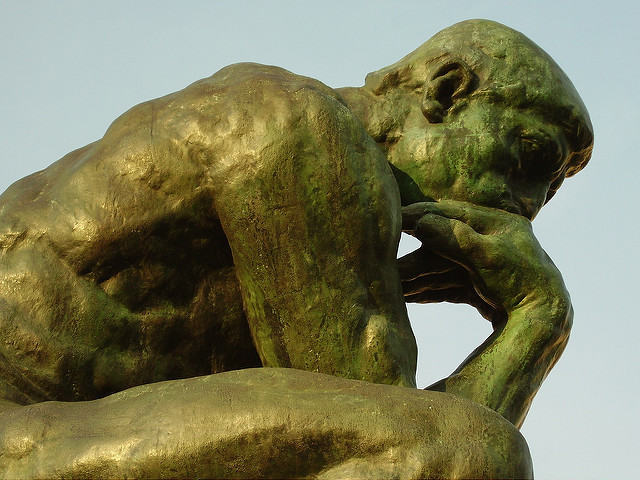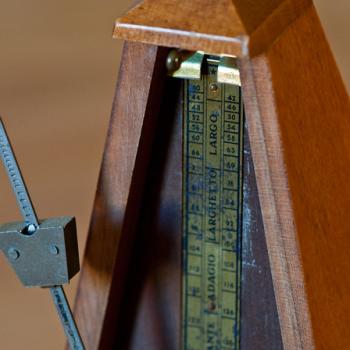
How Do We Find Time for Thinking?
We live our lives at the speed of leadership. Whether we have leadership responsibilities or are trying to keep up with someone else, we are moving. Sometimes we feel we do not have time even to catch our breath.
How do we find time we need for thinking?
For a long time I believed strong leaders did not really need time to think. I was convinced being a leader meant living a life of action in motion, not stopping to think. It was almost as if leaders had already taken their time for thinking and were now prepared for doing.
Leadership, after all, was about getting things done and moving forward. People who took too much time for thinking could fall into “analysis paralysis.”
Time for thinking may be an important part of preparing to lead. Now it is time to get moving.
The way I understand leadership has changed, particularly as I experience monastic leadership.
The leaders who inspire me find time to do their thinking. They remember their own core values and the values of their organizations. Inspiring leaders spend time reflecting on their values and how to put them into practice. They invest their thinking time in understanding what they have done and learning lessons for the future.
Leaders who inspire me recognize the value of finding time for thinking. They appreciate their thinking is more essential to them than planning or communication.
Time for thinking is essential to us as leaders. If we see the value of thinking, especially when life moves so quickly, how do we find time for thinking? How can we be thoughtful leaders when so many things demand our attention all at the same time?
Why Do We Need Time for Thinking?
Part of our difficulty in finding time for thinking is we mean several different things when we say “thinking.”
We may say, “I need to think about it” as a way to buy more time for ourselves before we answer.
Some of us tend to see people as either thinkers or feelers. We may need to experience our way into what we think or think our way through what we experience. When someone asks me how I feel about something I often respond by saying, “I think . . . ”
I often need time for thinking about how I feel.
Some of us believe thinking is primarily analytical. We need time for thinking to solve problems and sort through complicated information. When we spend time thinking we are trying to find the pieces of the puzzle and see how they fit together. Our thinking can be how we put ideas into categories so we can understand and remember them. Much of our thinking is immediate or short term. We want to analyze and understand as much as we can as quickly as possible.
Another kind of thinking is more reflective. We are not trying to find an objective answer or solution as much as decide how we see things. Reflective thinking is not the same as processing or interpreting information efficiently. We reflect almost by allowing thoughts and feelings to sort themselves out and tell us what they have to say.
Reflecting is not so much mastering information as it is letting it master us.
Many of us have little practical experience with reflecting. It takes us time to learn how to reflect and time to practice reflecting. There is a rhythm to reflection we cannot force or control.
Some of us think creatively, putting familiar ideas and concepts together in new ways.
The Practice of Taking Time For Thinking
It is not unusual for us to get ahead of ourselves. When we are asked to take on a project we want to jump in right away. We may forget about taking to for thinking before we get started.
The practice of taking time for thinking is as essential as planning or budgeting. We need to give ourselves the time we need to examine all the pieces and see the larger picture into which they fit. Taking time for thinking will help us foresee challenges and save time down the road.
Our taking time for thinking is an aspect of putting our values into practice. We recognize how important it is for us to think things through so we can do our best work.
Some of us prefer to take time for thinking by ourselves while others want to talk things over as a team. There may be particular people with whom we like to take time for thinking.
The leaders I know each have their own methods for thinking. Some want to raise all the questions they can. Others have developed their own ways to structure their time for thinking.
Leaders who inspire me appreciate the value time for thinking can add to their leadership.
Taking Time for Thinking Like a Monk
I will be driving back up to New Camaldoli in a couple of weeks. Each time I take a retreat there I am impressed by how monks take time for thinking.
Monastic days are scheduled to include time for analytical thinking as well as reflection. Benedictine monks follow a schedule based in Benedict’s Rule which recognizes the value of thinking.
Our work, whether community worship, individual projects, or manual labor, benefits from taking time for thinking. We listen, consider, ask questions, and come to a common understanding. Each step is important and the thinking of each person involved sheds light for all of us.
We seek a balance of analysis, reflection, creativity, and other kinds of thinking. We take time for thinking and learn the lessons each aspect has to teach us.
Our leadership is not merely about getting things done, but also how we value working together and the lessons it teaches us.
When we take time for thinking we are able to see past what usually distracts us.
When will we take time for thinking this week?
How will we practice taking time for thinking today?
[Image by Mark B. Schlemmer]
Greg Richardson is a spiritual life mentor and leadership coach in Southern California. He is a recovering attorney and university professor, and a lay Oblate with New Camaldoli Hermitage near Big Sur, California. Greg’s website is StrategicMonk.com, and his email address is [email protected].












